An amazing way to spend Veterans Day! Members of our team scouted locations and resources at the Museum of the American G.I. in College Station, Texas.
And why exactly? Because we want to film “re-enactment” scenes featuring the vehicles that are prominent in our story, and this Museum has them — fully restored and operational.

And these are just the vehicles currently indoors! Photo from the Museum website.
 Our host was the man behind the Museum, Brent Mullins. His quiet demeanor gives little evidence of the staggering achievement he’s made in collecting, repairing, restoring, and presenting these vehicles. We all agreed his work is nothing short of heroic.
Our host was the man behind the Museum, Brent Mullins. His quiet demeanor gives little evidence of the staggering achievement he’s made in collecting, repairing, restoring, and presenting these vehicles. We all agreed his work is nothing short of heroic.
The books you can see in this photo are a fraction of the library kept in his main workshop: the original “operating and repair” manuals for every vehicle in his collection. So he can not only collect parts from all over the world — he knows what to do with them, because he has the documentation of how to assemble the parts, repair them, and maintain them. Weird as it may sound, I think I was more impressed by his library of manuals than any other single thing on the grounds.
 If you know the “Train Near Magdeburg” story, you can imagine how honored we all felt to be given access to an M5A1 Stuart, the US Army tank that figures so prominently in the story.
If you know the “Train Near Magdeburg” story, you can imagine how honored we all felt to be given access to an M5A1 Stuart, the US Army tank that figures so prominently in the story.
Crew of four: three below and one above. From any of those positions, there two ways to see where you’re going: you either look through the small, flat periscope over your seat… or you stick your head out through a hatch, inviting the enemy to shoot you.
Note the white-star-in-a-circle emblem, the symbol of the US forces in Western Europe. That star is what the people from the train saw that let them know, in an instant, that friends had arrived. This star meant they had been saved. This is why I’ve made that the icon you see through our web site — to me, it’s the emblem of that moment of liberation.
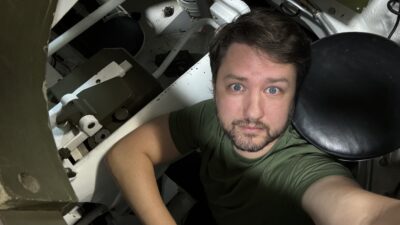 Director of Photography Chris Martin was the first of us to climb in, brave soul that he is. He worked his way into the driver’s seat first, then climbed out and re-entered through the turret. Since we’re eventually going to film in and around this machine, Chris has to figure out exactly how we should go about it. The space was designed to accommodate the men at their controls and almost nothing else — so how do you get a high-end movie camera in there?
Director of Photography Chris Martin was the first of us to climb in, brave soul that he is. He worked his way into the driver’s seat first, then climbed out and re-entered through the turret. Since we’re eventually going to film in and around this machine, Chris has to figure out exactly how we should go about it. The space was designed to accommodate the men at their controls and almost nothing else — so how do you get a high-end movie camera in there?
 With some twisting and stretching I was able to get into the driver’s seat. This fulfilled my personal mission for the trip: to sit where George Gross would have been on the morning of April 14, 1945… to imagine what it was like to be in that tiny space as he wistfully left the people of the train and drove — through the war zone — alone — from the train site in Farsleben to the fighting in Magdeburg. I climbed out with tears in my eyes.
With some twisting and stretching I was able to get into the driver’s seat. This fulfilled my personal mission for the trip: to sit where George Gross would have been on the morning of April 14, 1945… to imagine what it was like to be in that tiny space as he wistfully left the people of the train and drove — through the war zone — alone — from the train site in Farsleben to the fighting in Magdeburg. I climbed out with tears in my eyes.
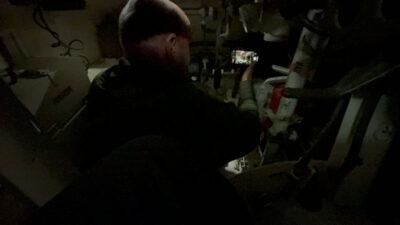
Because Chris was in the turret, he was able to look down into the driver’s seat and snap this photo of me as I was taking the selfie above. This gives you a better sense of how cramped and dark it is in there. Now imagine the ceaseless noise and choking fumes.
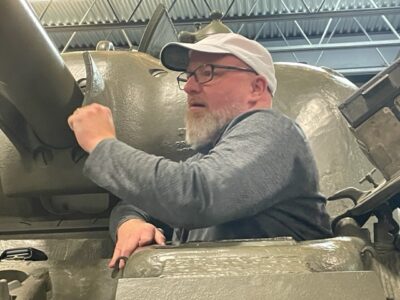 Exploring the Museum’s Sherman tank was an adventure for director Mike Edwards, WWII historian David Hilborn, and Chris Martin. Roomy compared to the M5A1, it’s still “close quarters” to say the least.
Exploring the Museum’s Sherman tank was an adventure for director Mike Edwards, WWII historian David Hilborn, and Chris Martin. Roomy compared to the M5A1, it’s still “close quarters” to say the least.
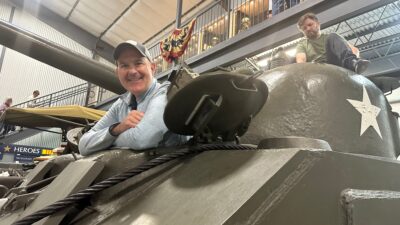 There were no Shermans in the encounter with the train, but they are important to our story nonetheless: several of the veterans who have contributed to our knowledge of the story were assigned to Shermans. The stories they tell, especially of D-Day, will figure prominently in Episode 2.
There were no Shermans in the encounter with the train, but they are important to our story nonetheless: several of the veterans who have contributed to our knowledge of the story were assigned to Shermans. The stories they tell, especially of D-Day, will figure prominently in Episode 2.
 This is how train survivor Ervin Abadi remembered — and immortalized — the joyous moment of liberation. It illustrates the visual power of the M5A1 in that moment, an image forever in the memory of all who were freed from the train. So in some ways it’s “just a tank,” a piece of machinery. But in others, the M5A1 is an icon of hope, of freedom, and of the triumph of good over evil.
This is how train survivor Ervin Abadi remembered — and immortalized — the joyous moment of liberation. It illustrates the visual power of the M5A1 in that moment, an image forever in the memory of all who were freed from the train. So in some ways it’s “just a tank,” a piece of machinery. But in others, the M5A1 is an icon of hope, of freedom, and of the triumph of good over evil.
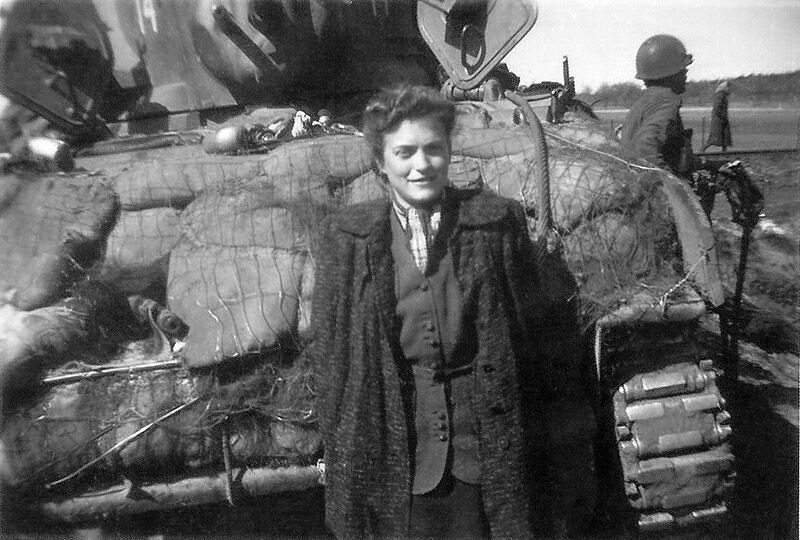 Several of the photos Sgt. Gross took on April 13, 1945 are of train survivors posing near his tank, including this one featuring Gina Rappaport. So we know we’ll need to “dress up” the Museum tanks for our eventual film shoot, carefully adding material to make the curated tank temporarily look like it’s been through more than 200 days of combat and reconnaissance. Brent Mullins has promised to help us do it … and you can believe he has the equipment and the knowhow to do it right.
Several of the photos Sgt. Gross took on April 13, 1945 are of train survivors posing near his tank, including this one featuring Gina Rappaport. So we know we’ll need to “dress up” the Museum tanks for our eventual film shoot, carefully adding material to make the curated tank temporarily look like it’s been through more than 200 days of combat and reconnaissance. Brent Mullins has promised to help us do it … and you can believe he has the equipment and the knowhow to do it right.